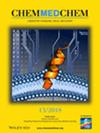Oxidative Coupling of Guanidines and Isocyanides Catalyzed by Nickel(II): Access to Imidazoline Derivatives with Antibacterial Activity
IF 3.6
4区 医学
Q2 CHEMISTRY, MEDICINAL
引用次数: 0
Abstract
A novel and concise approach to rare 2,3,5-triamino-imidazole scaffolds via Ni-catalyzed coupling of alkylisocyanides and N,N′-diarylguanidines has been developed. This reaction features include mild conditions (thermal or visible light activation), a wide substrate scope, and high efficiency. The coupling proceeds through a NiII/NiIV catalytic cycle, involving two-electron aerobic oxidation and the sequential insertion of two isocyanide units into Ni−N bonds.Testing these compounds against pathogens of the ESKAPE panel showed their high activity with a minimum inhibitory concentration down to 0.38 μg/mL.

镍催化下胍和异氰酸酯的氧化偶联:一种具有抗菌活性的咪唑啉衍生物的制备方法。
通过镍催化烷基异氰酸酯和N,N'-二芳基胍的偶联,建立了一种新的、简洁的方法来制备稀有的2,3,5-三氨基咪唑支架。该反应的特点是条件温和(热活化或可见光活化),底物范围广,效率高。提出了相应加合物形成的合理机理。这些化合物对ESKAPE面板病原菌的抑菌活性较高,最低抑菌浓度可达0.38 μg/mL。
本文章由计算机程序翻译,如有差异,请以英文原文为准。
求助全文
约1分钟内获得全文
求助全文
来源期刊

ChemMedChem
医学-药学
CiteScore
6.70
自引率
2.90%
发文量
280
审稿时长
1 months
期刊介绍:
Quality research. Outstanding publications. With an impact factor of 3.124 (2019), ChemMedChem is a top journal for research at the interface of chemistry, biology and medicine. It is published on behalf of Chemistry Europe, an association of 16 European chemical societies.
ChemMedChem publishes primary as well as critical secondary and tertiary information from authors across and for the world. Its mission is to integrate the wide and flourishing field of medicinal and pharmaceutical sciences, ranging from drug design and discovery to drug development and delivery, from molecular modeling to combinatorial chemistry, from target validation to lead generation and ADMET studies. ChemMedChem typically covers topics on small molecules, therapeutic macromolecules, peptides, peptidomimetics, and aptamers, protein-drug conjugates, nucleic acid therapies, and beginning 2017, nanomedicine, particularly 1) targeted nanodelivery, 2) theranostic nanoparticles, and 3) nanodrugs.
Contents
ChemMedChem publishes an attractive mixture of:
Full Papers and Communications
Reviews and Minireviews
Patent Reviews
Highlights and Concepts
Book and Multimedia Reviews.
 求助内容:
求助内容: 应助结果提醒方式:
应助结果提醒方式:


